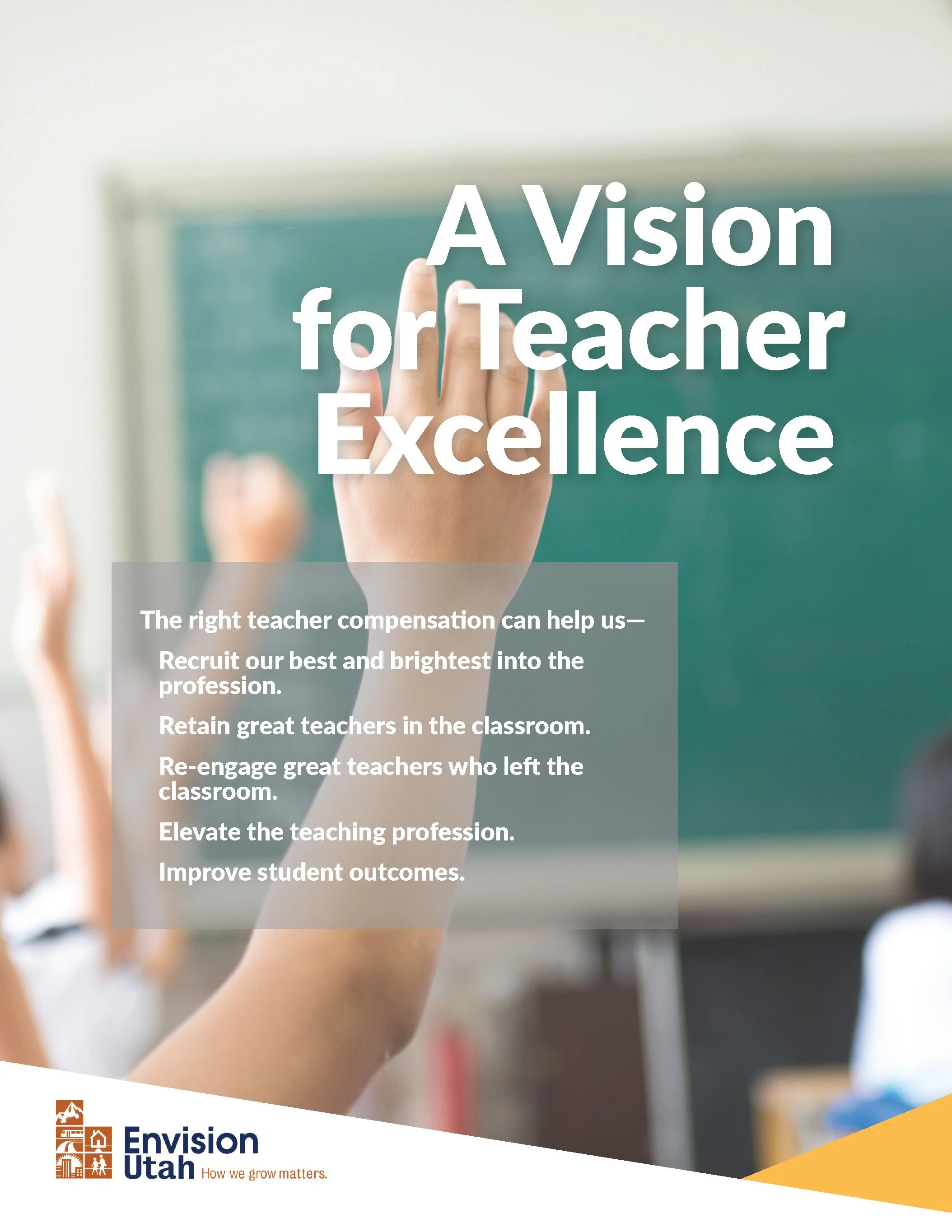The Original Vision
In an effort to make that vision a reality, we convened community leaders from education, government, and local businesses and conducted the largest-ever and most in-depth study of Utahns’ priorities and values related to education. Among the important findings, this taught us the outcomes Utahns expect from education as well as the importance they place on families and teachers (and the connection they see between funding and teachers) in getting those outcomes. We’ve continued to work with that committee to improve education for all Utahns.
Prior to this vision, we spent two years working to understand how best to support teachers. We polled more than 4,000 college students on their career choices and asked former teachers about returning to the classroom, and we conducted extensive public outreach. Not the least of all this, we worked with the Governor’s Office, the Utah State Board of Education, the Utah Education Association, and other education leaders to understand the numbers behind the teacher shortage and bring the teacher shortage to the forefront of education issues in the state.
As we worked on analyzing teacher compensation, it became clear that our we needed to look beyond teacher pay alone. In fact, when asked what teacher compensation should be, most people will have a list of conditions — changes that they believe necessarily go along with compensation to make teachers more effective. So we considered many other factors that could make the teaching profession more attractive or make our teachers more effective, with the goal of ensuring there is a highly effective teacher in every classroom so that students can get the knowledge and skills they need.
We identified potential variables related to teacher compensation. For example, how much do we pay teachers? What should teacher retirement benefits be? What would effective and attractive career advancement look like? We modeled how those variables fit together, and we created five scenarios that represented different choices among those variables. The preferred scenario that has become the vision outlined here is a combination and compromise between the most important elements in several of these scenarios.
The 2019 “Vision for Teacher Excellence” represented our best analysis and conclusions to date about what changes to compensation and other aspects of the profession would recruit and retain great teachers and lead to better student achievement. The vision created a new paradigm for what teacher compensation should look like. It shaped policy platforms. And schools, school districts, and state leaders have invested millions of dollars in improving teacher compensation. In many districts, teachers are beginning their careers with better training. And every year, more students have applied for scholarships to become teachers.
A Fresh Look at the Vision
But education has changed since 2019. The pandemic and remote learning changed the way society and teachers think about their role for better and for worse. Passionate debates about these roles have played out at the Capitol and all levels of school governance. Standard assessments also suggest student achievement dropped over the last few years as both the average test scores of Utah students and the percentage of students proficient in math and science decreased from 2019 to 2022.
At the same time—and likely as a result—fewer college students are entering teacher preparation programs this year than in any other year in recent memory. In addition, and in continuation of a long trend, more than half of our new teachers every year enter the profession without a teaching degree, which leads to demonstrably less effective instruction. Inflation and a tight labor market have also led to wage growth across the broader economy that has outpaced some of the gains made in teacher compensation.
Most importantly, Utah students need the best educators possible to prepare them for the future. Today’s students will need knowledge, critical thinking, and technical skills for jobs that may not even exist today. They will need social and emotional intelligence to thrive and lead in communities that seem to be increasingly complex. Indeed, if we truly want our children and grandchildren to be ready for the future, they need a world-class education.
In short, our key question—how to best attract and retain effective educators—may be even more relevant today than it was in 2019. In this updated and refreshed “Vision for Teacher Excellence,” we propose answers to that question.
This vision is just that—a vision. We do not pretend to outline the exact path forward. For example, we do not make recommendations about how to fund these changes to compensation. Nor do we delineate what should be state action and what should be local action. Instead, we provide a guide for the compensation we need to offer teachers in the current market in order to attract our best and brightest into the profession and keep great teachers in the classroom so that all students have access to the education they deserve. If we can stabilize the profession, we will improve instruction in our schools and lay the groundwork to optimize student learning. Utahns envision a bright future for education, and this is an important step to get there.


